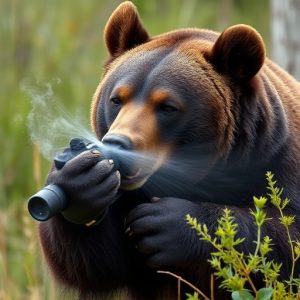Bear Spray: A Legal Defense Weapon for Ultimate Protection
Bear spray, a popular non-lethal defense against aggressive bears in bear country, contains capsaici…….
Bear spray, a popular non-lethal defense against aggressive bears in bear country, contains capsaicin which irritates and temporarily incapacitates them. While widely available for personal use without restrictions in many regions, its legal status varies globally with local hunting or park regulations. High-strength sprays may face stricter rules due to safety concerns. Understanding local laws is key to determining if bear spray is considered a restricted weapon. Its accessibility, effectiveness, and responsible usage make it a preferred option over firearms for outdoor enthusiasts seeking personal protection against bears in potential encounter zones.
“Bearing the brunt of a bear encounter can be terrifying. Enter bear spray, a maximum-strength defense weapon that offers a non-lethal yet effective solution. This powerful tool has gained popularity as a means of protection in bear country.
This article delves into the mechanics of bear spray, exploring its legal status and dispelling myths about it being a restricted weapon. We’ll also uncover its benefits and provide essential safe use guidelines for those venturing into bear-inhabited areas.”
- Understanding Bear Spray: What It Is and How It Works
- Legal Status: Is Bear Spray Considered a Restricted Weapon?
- Benefits of Bear Spray as a Defense Mechanism
- Safe Use and Handling Practices for Maximum Protection
Understanding Bear Spray: What It Is and How It Works
Bear spray, also known as bear repellent, is a maximum-strength defense weapon designed to deter and repel aggressive bears when outdoors in bear country. It’s a non-lethal option for self-defense against grizzly and black bears, offering an effective way to avoid or escape potential attacks. This powerful spray contains capsaicin, the active ingredient found in chili peppers, which irritates a bear’s eyes, nose, and respiratory system, temporarily disabling it and allowing you to create distance and escape.
Unlike firearms or other restricted weapons, bear spray is not limited by strict regulations across most jurisdictions. Its legal status varies globally, but generally, it’s considered an acceptable defense mechanism for outdoor enthusiasts, campers, and hikers in regions where bear encounters are common. The spray’s relatively low cost, ease of use, and wide availability make it a popular choice for those seeking to enhance their safety while exploring wilderness areas inhabited by bears.
Legal Status: Is Bear Spray Considered a Restricted Weapon?
In many regions, bear spray is classified as a defensive weapon, offering a non-lethal means of deterring aggressive bears. However, its legal status varies across different countries and states. While it is widely available for personal use, some areas have restrictions on its possession and application.
Determining if bear spray is considered a restricted weapon involves understanding local laws. In certain jurisdictions, it may be prohibited or regulated during specific activities like hunting or near national parks. Additionally, the concentration of capsaicin (the active ingredient) can impact its classification. High-strength bear sprays, often marketed as “maximum strength,” might face stricter regulations to ensure their use aligns with safety guidelines and does not pose risks to wildlife or bystanders.
Benefits of Bear Spray as a Defense Mechanism
Bear spray, often considered a non-lethal weapon, offers significant advantages as a defense mechanism against bears. One of its key benefits is accessibility; it’s an easily transportable option for outdoor enthusiasts, campers, and hikers, especially in regions where bear encounters are common. Unlike firearms, which may be restricted or require specialized training to use, bear spray is generally available without a permit, making it a convenient choice for those seeking protection during their outdoor activities.
Another advantage lies in its effectiveness. Bear spray creates a barrier of capsaicin-based chemicals that temporarily incapacitate the animal, providing precious time for retreat or assistance. Unlike other deterrents, it poses minimal harm to humans and wildlife if used correctly, making it a responsible option for bear defense. This non-lethal approach respects the natural balance while ensuring personal safety during potential encounters.
Safe Use and Handling Practices for Maximum Protection
When using bear spray as a maximum strength defense weapon, it’s crucial to adhere to safe handling practices for optimal protection. Always inspect the can before use, ensuring there are no signs of damage or pressure buildup. Check the expiration date and make sure the seal is intact. Bear spray is not a restricted weapon, but responsible usage is key. Keep it out of reach of children and store it in a secure, cool place away from direct sunlight.
To maximize its effectiveness, understand the recommended distance for application—typically 2-3 meters (6-10 feet). Aim for the bear’s face and eyes, as these areas are sensitive. Never point the spray at anyone unintentionally; practice target practice to get a feel for the range and spread. Regularly maintain and clean your spray device according to the manufacturer’s instructions, ensuring it’s always ready for use in an emergency.
Bear spray, while not universally classified as a restricted weapon, should be treated with caution and respect. Its maximum strength and effectiveness as a defense mechanism against bears make it a valuable tool for outdoor enthusiasts in bear country. However, understanding local regulations regarding its possession and use is crucial to ensure legal compliance and maximize personal safety. Following safe handling practices can help prevent accidents and ensure that bear spray remains a reliable line of defense when faced with an aggressive bear encounter.


